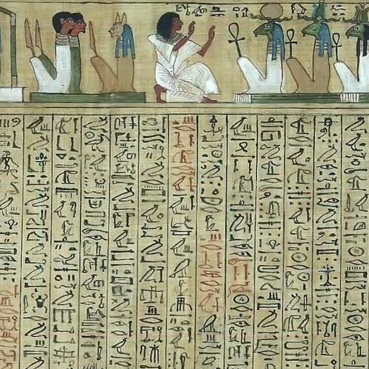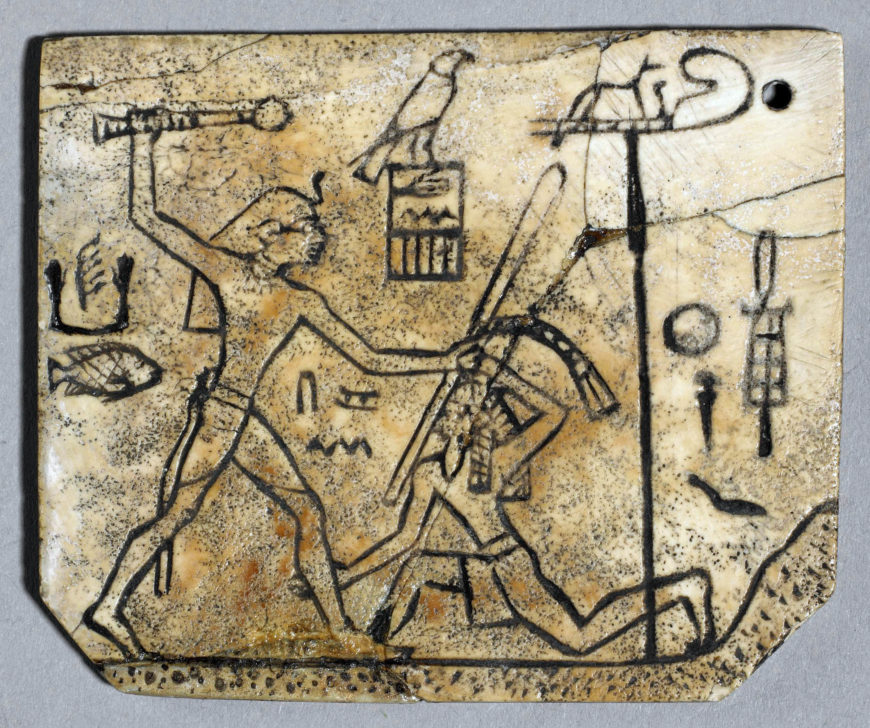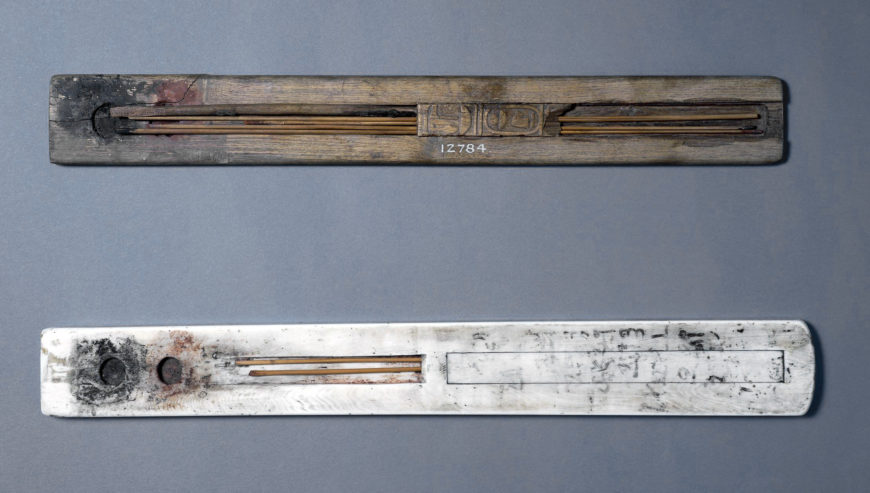
Hunefer’s Judgement in the presence of Osiris, Book of the Dead of Hunefer, 19th Dynasty, New Kingdom, c. 1275 B.C.E., papyrus, Thebes, Egypt (British Museum)
It is not known exactly where and when Egyptian writing first began, but it was already well-advanced two centuries before the start of the First Dynasty that suggests a date for its invention in Egypt around 3,000 B.C.E. The most well-known script used for writing the Egyptian language was in the form of a series of small signs, or hieroglyphs.
Some signs are pictures of real-world objects, while others are representations of spoken sounds. These sound signs are pictures that get their meaning from how the word for the object they represent sounds when said aloud. Some signs write one letter, some more, while others write whole words.
Like cuneiform, Egyptian hieroglyphs were used for record-keeping, but also for monumental display dedicated to royalty and deities. The word hieroglyph comes from the Greek hieros ‘sacred’ and gluptien ‘carved in stone’. The last known hieroglyph inscription was 394 C.E.
Other scripts used to write Egyptian were developed over time. Hieratic was handwritten and easier to write so was used for administrative and non-monumental texts from the Old Kingdom (about 2613–2160 B.C.E.) to around 700 B.C.E. Hieratic was replaced by demotic, which means popular, in the Late Period (661–332 B.C.E.), and was a more abbreviated version. In turn demotic was replaced by Coptic, which may have been introduced to record the contemporary spoken language, in the first century C.E.

King Den’s sandal label, c. 2985 B.C.E., Early Dynastic Period, 1st dynasty, ivory, found at Abydos, Upper Egypt, 4.5 x 5.3 cm (© Trustees of the British Museum)
Labels
Most ivory plaques dating to the First Dynasty were made as labels. The pair of sandals incised on the back of this one indicates that it was a label for sandals, which were extremely prestigious items.
Labels such as these were usually decorated with representations of important events and this example shows Den, the fifth king of the First Dynasty, about to bring his mace down on the head of his vanquished enemy. The name of the king is written in the rectangular frame in front of his face, with the figure of a falcon, a symbol of royalty, above. The hieroglyphs behind the king give the name of one of his high officials, Inka.
This label is one of the few sources for information about activity inside or outside Egypt in the Early Dynastic period. The hieroglyphs on the right-hand side of the label read ‘first occasion of smiting the East’. That the enemy is an Easterner is indicated by his long locks and pointed beard. The gravel-spotted desert which serves as a ground-line rises to a hill on the right, suggestive of Egyptian depictions of foreign lands.
Such illustrations are a standard way of depicting kings and do not necessarily mean that any such campaign ever took place. Kings are shown, over a period of 2,000 years, smiting Libyan chiefs—some with the same name! However, all standard motifs must have a prototype, and, being one of the earliest known, this example might refer to a real historical event.

Two scribal palettes with ink wells and brushes, 18th Dynasty, 1550–1450 B.C.E., ivory, from Thebes, Egypt, 30.5 x 3.8 cm (© Trustees of the British Museum)
Written in black and red
The hieroglyphic sign for ‘write’ was formed from an image of the scribal palette and brush case. Statues of scribes are sometimes shown with a papyrus across their knees and a palette, the scribe’s trademark, over one shoulder.
From the late Old Kingdom on, the basic palette was made of a rectangular piece of wood, with two cavities at one end to hold cakes of black and red ink. Carbon was used to make the black ink and iron-rich red ochre to make the red. Both pigments were mixed with gum so that they congealed rather than turned to dust when they dried. The cakes of ink were moistened with a wet brush, rather like modern watercolors or Chinese ink. Brush-pens were made of rushes, the tip cut at an angle and chewed to separate the fibers. These were kept in a slot in the middle of the palette.
Black was the normal color for writing. Red was used to mark the start of a text, or to highlight key words and phrases, like quantities in medicines, or for the names of demons in religious papyri. More colors were needed for illustrations, such as those in the Book of the Dead.
© Trustees of the British Museum
Additional resources:
Brovarski and others (eds), Egypts golden age: the art of living in the New Kingdom (Museum of Fine Arts, Boston, 1982)
E.R. Russmann, Eternal Egypt: masterworks of ancient art from the British Museum (University of California Press, 2001)
Parkinson, Cracking codes: the Rosetta Stone and Decipherment (London, The British Museum Press, 1999)
Quirke and A.J. Spencer, The British Museum book of ancient Egypt (London, The British Museum Press, 1992)

